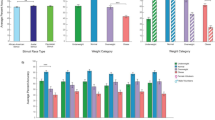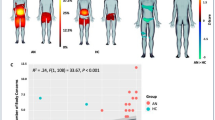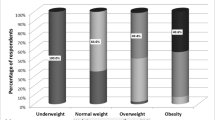Abstract
OBJECTIVE: A new measure of body image, named the body image assessment for obesity (BIA-O) was developed and tested for reliability and validity in a sample of 1209 adult men and women. Separate BIA-O procedures were developed for men and women. Current, ideal and reasonable body image estimates of Caucasian and African-American men and women were compared.
METHOD: Figural stimuli of males and females were developed for body sizes ranging from very thin to very obese in 18 increments. Participants selected figures that represented estimates of current, ideal and reasonable (a body size that could be maintained over time) body size. Some participants (n=641) also completed two measures of body dissatisfaction in a test of the validity of the BIA-O as a measure of body dissatisfaction. A sample of 77 participants was administered the BIA-O on two occasions to test the test–retest reliability of the BIA-O.
RESULTS: The reliability of the BIA-O was supported by test–retest reliability coefficients which ranged from 0.65 to 0.93. Concurrent validity of the discrepancy between current and ideal and current and reasonable body size estimates was supported by positive correlations with two measures of body dissatisfaction. The BIA-O body size estimates of Caucasians and African-Americans, controlled for age and BMI, were compared. As BMI increased, Caucasian men and women were found to select larger current body size estimates in comparison to African-Americans.
DISCUSSION: The reliability and validity of the BIA-O were supported. Greater body size dissatisfaction in obese Caucasians, relative to African-Americans of the same size, may be a function of biased estimates of current body size.
This is a preview of subscription content, access via your institution
Access options
Subscribe to this journal
Receive 12 print issues and online access
$259.00 per year
only $21.58 per issue
Buy this article
- Purchase on Springer Link
- Instant access to full article PDF
Prices may be subject to local taxes which are calculated during checkout



Similar content being viewed by others
References
Rosen JC . Improving body image in obesity. In Thompson JK (ed.) Body Image, Eating Disorders, and Obesity: An Integrative Guide for Assessment and Treatment American Psychological Association: Washington, DC 1996, pp 425–440.
Thompson JK . Assessing body image disturbance: measures, methodology, and implementation. In Thompson JK (ed.) Body Image, Eating Disorders, and Obesity: An Integrative Guide for Assessment and Treatment American Psychological Association: Washington, DC 1996, pp 49–83.
Altabe MN . Issues in the assessment and treatment of body image disturbance in culturally diverse populations. In Thompson JK (ed.) Body Image, Eating Disorders, and Obesity: an Integrative Guide for Assessment and Treatment American Psychological Association: Washington, DC 1996, pp129–147.
Altabe M . Ethnicity and body image: quantitative and qualitative analysis Int J Eat Disord 1998 23: 153–159.
Rosen EF, Anthony DL, Booker KM, Brown TL, Christian E, Crews RC, Hollins VJ, Privette JT, Reed RR, Perry LC . A comparison of eating disorder scores among African-American and White college females Bull Psychon Soc 1991 29: 65–66.
Rucker CE, Cash TF . Body images, body-size perceptions and eating behaviors among African-American and White college women Int J Eat Disord 1992 12: 291–299.
Williamson DA, Davis CJ, Bennett SM, Goreczny AJ, Gleaves DH . Development of a simple procedure for assessing body image disturbances Behav Assess 1989 11: 433–446.
Higgins ET . Self-discrepancy: a theory relating self and affect Psychol Rev 1987 94: 319–340.
Williamson DA . Assessment of Eating Disorders: Obesity, Anorexia, and Bulimia Nervosa Pergamon Press: Elmsford, NY, 1990.
Williamson DA, Gleaves DH, Watkins PC, Schlundt DG . Validation of self-ideal body size discrepancy as a measure of body dissatisfaction J Psychopathol Behav Assess 1993 15: 57–68.
Williamson DA, Cubic BC, Gleaves DH . Equivalence of body image disturbances in anorexia and bulimia nervosa J Abnorm Psychol 1993 102: 177–180.
Williamson DA, Davis CJ, Goreczny AJ, Blouin DC . Body image disturbances in bulimia nervosa: influences of actual body size J Abnorm Psychol 1989 98: 97–99.
Williamson DA, Kelley ML, Davis CJ, Ruggiero L, Blouin D . Psychopathology of eating disorders: a controlled comparison of bulimic, obese, and normal subjects J Consult Clin Psychol 1985 53: 161–166.
Veron-Guidry S, Williamson DA . Development of a body image assessment procedure for children and preadolescents Int J Eat Disord 1996 20: 287–293.
Williamson DA, O'Neil PM . Behavioral and psychological correlates of obesity. In Bray G, Bouchard C, James P (eds) Handbook of Obesity Marcel Dekker: New York 1998, pp 129–142.
Foster GD, Thomas AW, Vogt, RA, Brewer G . What is a reasonable weight loss? Patients' expectations and evaluations of obesity treatment outcomes J Consult Clin Psychol 1997 65: 79–85.
Cooper PJ, Taylor MJ, Cooper Z, Fairburn CG . The development and validation of the Body Shape Questionnaire Int J Eat Disord 1987 6: 485–494.
Williamson DA, Barker SE, Bertman LJ, Gleaves DH . Body image, body dysphoria, and dietary restraint: factor structure in nonclinical subjects Behav Res Ther 1995 33: 85–93.
Garner DM . Eating Disorders Inventory—2 Psychological Assessment Resources: Odessa FL 1991.
Williamson DA, Anderson DA, Gleaves DH . Anorexia nervosa and bulimia nervosa: structured interview methodologies and psychological assessment. In Thompson JK (ed) Body Image, Eating Disorders, and Obesity: an Integrative Guide for Assessment and Treatment American Psychological Association: Washington, DC 1996, pp 205–223.
Gardner RM, Friedman BN, Jackson NA . Methodological concerns when using silhouettes to measure body image Percept Mot Skills 1998 86: 387–395.
Williamson DA . Body image disturbances in eating disorders: a form of cognitive bias? Eat Disord J Treatment Prev 1996 4: 47–58.
Acknowledgements
The authors would like to acknowledge the efforts of David M Levine, MD, ScD, MPH and Rebecca Stallings, MHS at Johns Hopkins University and Nicole Mickley at Pennington Biomedical Research Center in the collection of data used in this study.
Author information
Authors and Affiliations
Corresponding author
Appendix
Appendix
t-Scores for each gender and race group may be calculated using the following equation and regression coefficients: 
For example, the following is the regression line for CBS for Caucasian women:
y=0.339(BMI)−2.148
such that b1=0.339 and b0=−2.148. The standard error of measurement is 2.1047. Therefore, a t-score for a Caucasian woman with a BMI=35 who selected a CBS=8 would be calculated as: 
=41.84 ≅ 42
The equation can be used to generate t-scores for IBS and RBS as well.
The following scenario illustrates the usefulness of t-scores in conceptualizing body image disturbances:
-
Person A is a Caucasian woman with a BMI of 35. Her body image selections are: CBS=13 (t-score=66), IBS=4 (t-score=44), RBS=5 (t-score=44).
-
Person B is a Caucasian woman with a BMI of 35. Her BIA-O selections are: CBS=10 (t-score=51), IBS=5 (t-score=50), RBS=6 (t-score=50).
A review of the t-scores indicates that Person A has a large discrepancy between her CBS and IBS t-scores (difference=22), whereas Person B has little discrepancy. Such a guideline would indicate that Person A is more dissatisfied with her body size and shape than Person B, despite equal BMIs and comparable IBS and RBS selections.
Rights and permissions
About this article
Cite this article
Williamson, D., Womble, L., Zucker, N. et al. Body image assessment for obesity (BIA-O): development of a new procedure. Int J Obes 24, 1326–1332 (2000). https://doi.org/10.1038/sj.ijo.0801363
Received:
Revised:
Accepted:
Published:
Issue Date:
DOI: https://doi.org/10.1038/sj.ijo.0801363
Keywords
This article is cited by
-
Psychological characteristics of patients seeking bariatric treatment versus those seeking medical treatment for obesity: is bariatric surgery a last best hope?
Eating and Weight Disorders - Studies on Anorexia, Bulimia and Obesity (2021)
-
“I Want to Lose Weight and it Has to Be Fair”: Predictors of Satisfaction After Bariatric Surgery
Obesity Surgery (2021)
-
Development and validation of the body shape scale (BOSHAS) for assessing body shape perception in African populations
BMC Public Health (2020)
-
Body image perception of African immigrants in Europe
Globalization and Health (2016)
-
The relevance of the side-view in body image scales for public health: an example from two African populations
BMC Public Health (2015)



